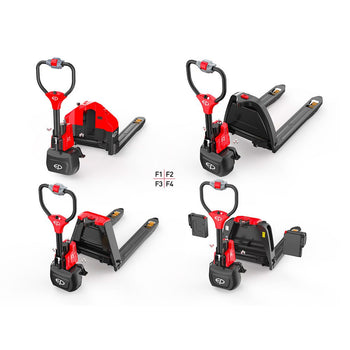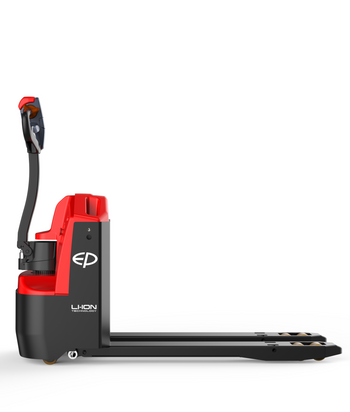Warehouse managers face a dizzying array of material‑handling equipment. Choosing between a reach truck and a counterbalance forklift isn’t just about picking the biggest machine – it’s about matching the equipment to your aisles, storage height, load types and warehouse workflow. This in‑depth guide compares these two workhorses, explaining how they differ and when each is the right tool.
What is a counterbalance forklift?
Counterbalance forklifts are the most common type of lift truck on the market. As the name implies, they rely on a heavy counterweight located behind the operator to offset the weight of the load at the front. The forks are permanently fixed to the front of the mast, and the truck drives straight up to a pallet to lift and carry it. Typical capacities range from about 1.5–5+ tonnes and lift heights are generally 4–7 m. Counterbalance trucks are extremely versatile: depending on tyre type they can work indoors or outdoors, and manufacturers offer electric, LPG, diesel and even hydrogen fuel‑cell models. Because the operator usually sits facing forward, visibility to the forks and load is good, and control systems can range from traditional steering wheels and levers to fingertip or joystick controls.
Counterbalance forklifts excel at general warehousing, yard work and loading docks. Their heavy rear weight allows them to handle large loads – some heavy‑duty models lift well over 25,000 lb – and attachments such as rotators, clamps and sweepers make them true multitaskers. However, that counterweight also makes them long, so they need aisle widths of roughly 3.5–4.5 m (about 10–12 ft) to turn safely. If your warehouse aisles are narrow, manoeuvring can become awkward.
What is a reach truck?
Reach trucks are specialist forklifts designed to maximise storage density in high‑bay warehouses. Instead of a counterweight, they stabilise the load with two forward‑projecting legs and a pantograph mechanism that lets the forks extend forward into a pallet rack. This design shortens the overall body length, allowing the truck to operate in aisles as narrow as 2.5–3 m (around 8 ft) – significantly narrower than typical counterbalance forklifts. Reach trucks are almost always battery‑powered, so emissions and noise are low, and they are intended for smooth, indoor floors.
With their extending mast, reach trucks can lift to heights of 8–12 m or more and some models exceed 40 ft. They sacrifice lifting capacity for height; most units are rated between 1–2.5 tonnes, with heavy models topping out around 4,500 lb. Operators often stand or sit sideways, using a steering wheel and a joystick with a dead‑man pedal for safety. Visibility to the load can be more obstructed than on a counterbalance forklift because the mast is directly in front of the driver, but the side‑facing position helps.
Reach trucks thrive in pallet racking systems where space utilisation and vertical storage are priorities. By reducing aisle width, they can increase pallet positions by 20–30 % compared with counterbalance‑only operations. Their pantograph arm allows double‑deep storage, letting operators place or retrieve pallets two positions deep without moving the truck.

Comparing capabilities
Aisle width and manoeuvrability
Aisle width is often the deciding factor between reach and counterbalance trucks. Standard counterbalance forklifts require 3.5–4.5 m (10–12 ft) of clearance to turn safely. In contrast, reach trucks can operate in aisles just 2.5–3 m wide (about 8 ft) because the forks extend into the rack while the body remains clear. Mid Columbia Forklift notes that losing the rear counterweight and narrowing the wheelbase makes reach trucks more manoeuvrable, allowing them to work in aisles as narrow as 8 ft. If your warehouse needs to maximise pallet positions or retrofit existing space, moving to narrow aisles and reach trucks can free up significant storage capacity.
Counterbalance forklifts still handle tight turns reasonably well, but their long rear overhang can make sharp manoeuvres in narrow aisles risky. They are better suited to mixed environments where trucks must travel from yard to warehouse or where there are wide staging areas and loading docks. When the facility layout includes tight doorways, curved aisles or congested zones, consider the smaller turning radius of a reach truck.
Lift height
A critical difference is lift height. Counterbalance forklifts typically top out at 4–7 m (13–23 ft), although some high‑mast models reach about 20 ft. Reach trucks are purpose‑built for height: most standard models lift pallets between 8–12 m, and some lift to 40 ft or higher. This capability makes reach trucks ideal for warehouses with multi‑tier racking or mezzanine levels. If you plan to expand vertically, a reach truck offers room for growth; if your racking is low, a counterbalance may suffice.
Load capacity and stability
Counterbalance forklifts are robust machines capable of lifting very heavy loads. Models routinely handle 1.5–5 tonnes, and heavy‑duty versions can exceed 25,000 lb or even 100,000 lb. Their counterweight balances loads outside the wheelbase, allowing them to pick up wide or awkward items. Attachments like rotators, clamps and carpet poles add versatility.
Reach trucks trade capacity for reach. They’re designed for palletised loads up to 2.5 tonnes, with heavy models topping around 4,500 lb. Because the mast extends, the load remains within the wheelbase while being lifted, and base legs support the weight. This design provides stability but limits load size; handling very heavy, off‑centre or oversized items is better done with a counterbalance. Reach trucks also tend to have narrower forks and may not accommodate large attachments beyond a sideshifter.
Power source and environment
Power choices influence operating costs and where each truck can work. Counterbalance forklifts are available with electric, LPG, diesel, gasoline and even hydrogen fuel‑cell power. With pneumatic tyres, they operate on uneven outdoor surfaces; cushion tyres suit indoor floors. This versatility makes them suitable for yards, loading bays, construction sites and docks. However, internal‑combustion models emit fumes and noise, which can be problematic indoors.
Reach trucks are exclusively electric. Battery power means zero emissions and low noise, making them perfect for indoor environments where air quality matters. They use cushion or polyurethane tyres and require smooth floors. Without a combustion engine, they have lower vibration and are generally quieter and easier on operators.
Operator comfort and controls
Most counterbalance forklifts feature a seated operator compartment with a steering wheel, gear selector and pedals similar to a car. Some stand‑up models exist for high‑frequency operations, but the norm is a sit‑down cab with good forward visibility. Reach trucks often position the driver sideways; controls typically include a steering wheel and a joystick that controls travel and hydraulic functions, plus a dead‑man pedal to stop the truck when the operator steps off. Because the mast is in front of the operator, forward visibility can be obstructed, and training is required to maintain awareness. Modern electronic controls on reach trucks allow precise manoeuvring and fingertip operation.

Selecting the right truck for your warehouse
Every warehouse is different, so consider how each truck’s characteristics align with your operation.
Warehouse size and layout
If your facility has standard aisles and you handle a variety of loads, a counterbalance forklift provides the most flexibility. It can travel from yard to warehouse, load lorries, work on ramps and handle non‑palletised goods. For narrow aisles where maximising storage density is vital, a reach truck’s compact chassis and pantograph are invaluable. Replacing wider aisles with narrow aisles can increase pallet positions by 20–30 %, so the investment in reach trucks can pay off quickly in expensive real estate.
Load types and weight
Consider the weight and shape of your typical loads. Heavy or bulky items, large pallets and loads that extend beyond the forks require the counterbalancing stability of a counterbalance forklift. If loads are standard pallets within the 1–2.5 tonne range, a reach truck can easily handle them. For double‑deep racking, a reach truck’s pantograph reduces the need for aisles on both sides of the rack.
Height requirements
Evaluate your rack heights and future growth plans. A reach truck’s ability to lift 8–12 m or even 40 ft makes it ideal for high‑bay warehouses, mezzanines and multi‑tier storage. If your racking is limited to 4–7 m, a counterbalance forklift may meet your needs. Keep in mind that lifting height affects overall truck stability; training is important for safe high‑level stacking.
Mixed indoor/outdoor operations
Do your trucks need to cross thresholds, work on uneven ground or operate outdoors? Counterbalance forklifts with pneumatic tyres thrive in mixed environments. Reach trucks are designed for smooth indoor surfaces and should not be used on rough terrain.
Training and certification
The UK Health and Safety Executive (HSE) classifies lift trucks by category. Counterbalance forklifts are covered under categories B1 (up to 5 tonnes), B2 (5–15 tonnes) and B3 (over 15 tonnes), while reach trucks fall under category D1 (standard reach) or D2 (stacking above 8 m). Operators must complete approved training for the specific truck type and capacity; skills do not automatically transfer between categories. Training typically lasts three to five days for novice operators.
Costs and return on investment
Electric reach trucks and counterbalance forklifts have different cost structures. Manual pallet jacks may cost under about £370, but powered pallet trucks – essentially small ride‑on reach vehicles – typically range from roughly £1,480 to £4,440. Electric trucks have higher upfront costs but lower emissions and often lower maintenance because lithium‑ion batteries require minimal servicing. The total cost of ownership includes not just purchase price but labour efficiency, downtime, safety and longevity. Many businesses find that electric units pay for themselves quickly when operators move pallets frequently or over long distances.
Counterbalance forklifts powered by internal‑combustion engines may have lower purchase prices than lithium‑ion reach trucks, but fuel, emissions, noise and maintenance must be factored in. Diesel and LPG prices fluctuate, and scheduled maintenance on engines and transmissions can be significant. Electric counterbalance models exist, often commanding a higher purchase price but offering lower running costs and zero emissions.
Explore iLift’s pallet truck range
iLift specialises in lithium‑ion powered equipment, and their electric pallet trucks make an excellent complement to both reach and counterbalance forklifts. Two standout models illustrate how modern pallet trucks can streamline warehouse operations:
WPL201 Electric Pallet Truck
The WPL201 is a compact, high‑performance electric pallet truck optimised for narrow aisles and tail‑lift work. It uses plug‑and‑play components for easy servicing and features a 48 V brushless DC motor that provides enough power for demanding warehouse tasks. The truck handles up to 2 tonnes and is designed for indoor use on smooth floors. Its maximum lift height is around 115 mm—ideal for raising pallets to a comfortable height for transport. With a compact footprint, the WPL201 excels at manoeuvring in tight spaces and offers a low total cost of ownership.
F‑Series Pallet Trucks
iLift’s F Series electric pallet trucks (models F1–F4) are versatile units rated at 1.5 tonnes with a 24 V lithium battery. All models share a common platform to simplify operation and reduce parts inventory. The series emphasises manoeuvrability; advanced steering mechanisms allow operators to navigate narrow aisles easily, making them perfect partners for reach trucks in high‑density storage. Routine maintenance involves simple battery and tyre checks, and optional weather‑resistant features allow limited outdoor use. With multiple chassis configurations, managers can choose the F Series model that best suits their application.
Whether you’re optimising a new warehouse or retrofitting an existing facility, iLift’s lithium‑powered pallet trucks integrate seamlessly with reach or counterbalance forklifts. They provide an efficient way to move pallets to staging areas, loading docks or order‑picking zones. For pricing, demonstrations and advice, contact iLift’s team on 01600 800 800 or enquiry@ilift.co.uk. Their specialists can assess your layout and recommend equipment tailored to your needs.

Conclusion
Choosing between a reach truck and a counterbalance forklift hinges on understanding your warehouse’s unique requirements. Counterbalance forklifts offer powerful lifting capacity, adaptability and the ability to work indoors or outdoors. Reach trucks maximise storage density, navigate narrow aisles and lift pallets to heights beyond the reach of most counterbalance models. Assess aisle width, rack height, load characteristics, environment and budget to determine which machine provides the best return on investment. Complementary equipment like iLift’s WPL201 and F Series electric pallet trucks can further boost productivity by streamlining pallet movement and freeing up your forklift for heavy lifting. Armed with these insights, warehouse managers can confidently specify the right trucks to keep operations running smoothly.




